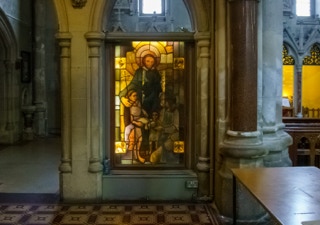Unfortunately I have never mastered the art of photographing within buildings, especially churches but it is possible that I am constrained by the fact that I do not employ flash.
St. Peter's is noted for its beautiful stained glass windows, particularly the west window and Harry Clarke's early masterpiece entitled The Adoration of the Sacred Heart. The window depicts, among scenes of the life of Jesus Christ, the adoration of the Sacred Heart with Ss. Mary Magdalene and John the Evangelist.
St. Peters is richly decorated with Gothic embellishments, such as gargoyles, pinnacles, bosses and columns made from Newry granite.
In the early 19th century, Phibsborough was a crime-ridden suburb home to many families living in poverty. Ultimately, the concern for the children of Phibsborough resulted in the founding of a Catholic school in 1826. Two of the priests running this school, Rev. W. Young and Rev. W. Carroll, converted the top floor of the school into a chapel.
In 1838 the Vincentian order, under Dean Philip Dowley, took over the running of the church.
In 1843, new school buildings were built to house the growing number of students. The second floor of the old structure was removed and the chapels length was augmented, leaving it 123 feet (37 m) long and 35 feet (11 m) high. In 1907, work on the spire apparently commenced after Cardinal Moran of Australia commented on the lack of Catholic church spires in the Dublin skyline.
St Peter's Church is recognised as an important landmark in North Dublin. In 1984 Bernard Neary wrote:
You could hardly be called a Dubliner if you hadn't heard of St. Peter's Church, Phibsborough. Standing proudly on Dublin's Northside, each stone of this noble landmark bears the story of hundreds of Irish people of many generations who dared to dream a dream.



























